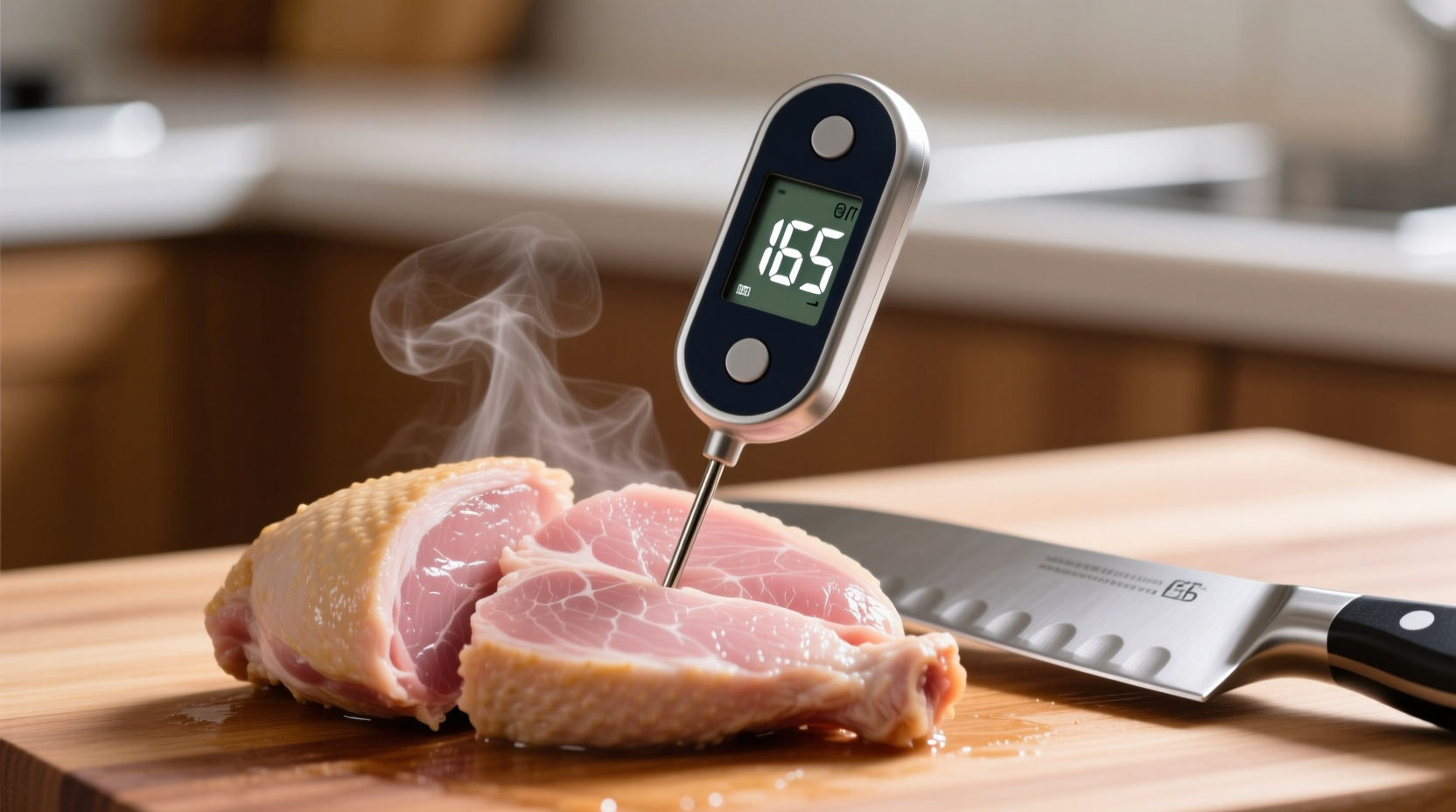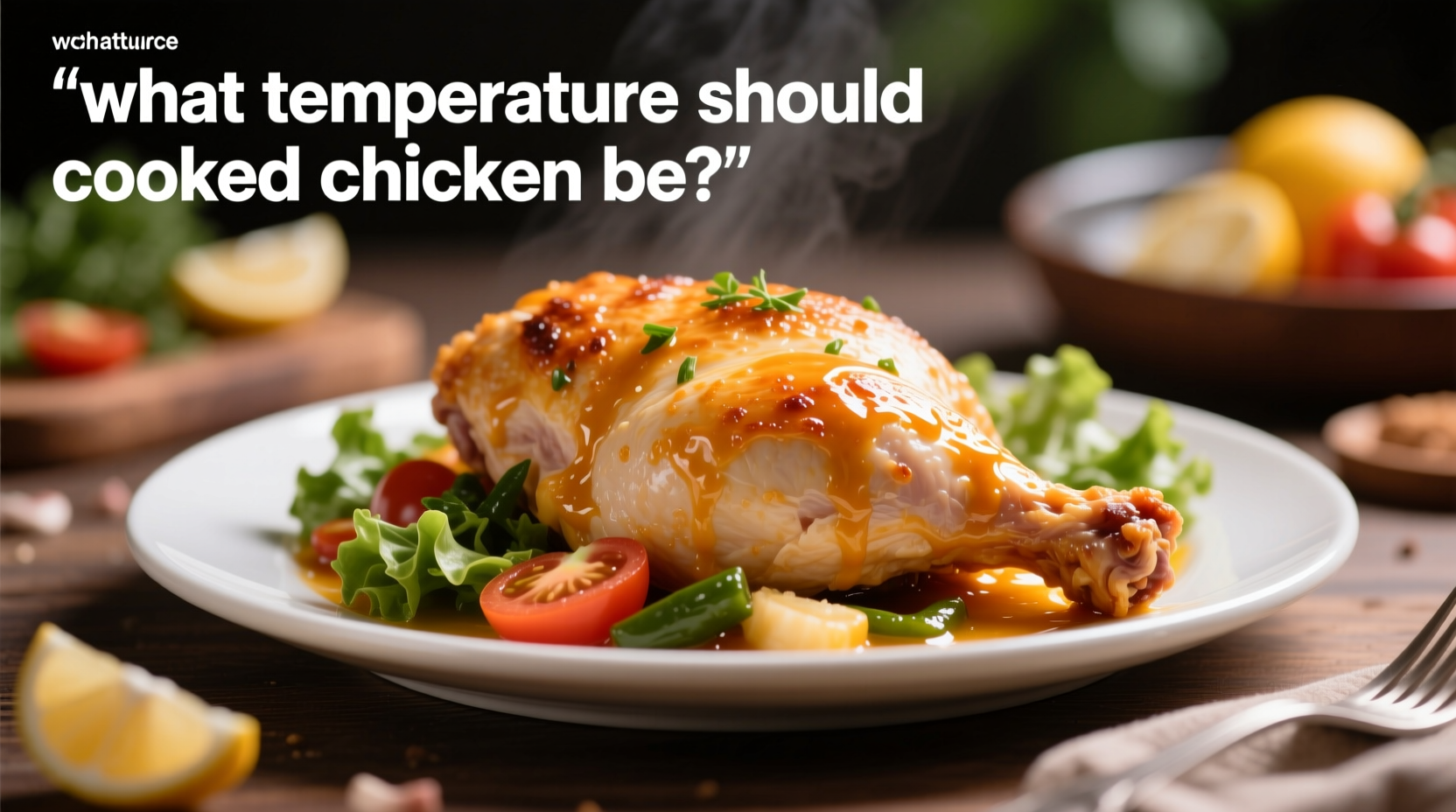The safe internal temperature for cooked chicken is 165°F (74°C) according to the USDA Food Safety and Inspection Service. This temperature destroys harmful bacteria like Salmonella and Campylobacter that can cause foodborne illness.
Knowing the precise temperature for cooked chicken isn't just culinary precision—it's your first line of defense against foodborne illness. Each year, millions of people experience food poisoning from improperly cooked poultry, with chicken being a leading culprit. Getting this number right separates a safe, delicious meal from a potential health emergency.
Why 165°F Is Your Chicken's Safety Threshold
Chicken requires special attention because it commonly harbors Salmonella and Campylobacter bacteria. These pathogens don't just disappear when meat turns white—they require specific heat exposure to be eliminated. The USDA's 165°F standard represents the temperature at which these bacteria are instantly destroyed.
"Many home cooks rely on color or texture to determine doneness, but these methods are dangerously unreliable," explains food safety expert Dr. Mindy Brashears, former USDA Deputy Under Secretary for Food Safety. "Only a properly calibrated thermometer provides certainty."
| Meat Type | Safe Minimum Internal Temperature | Rest Time After Cooking |
|---|---|---|
| Chicken, Turkey (all parts) | 165°F (74°C) | No rest required |
| Ground Meats (beef, pork, veal, lamb) | 160°F (71°C) | No rest required |
| Beef, Pork, Veal, Lamb (steaks, roasts, chops) | 145°F (63°C) | 3 minutes |
| Fish | 145°F (63°C) | No rest required |
How to Measure Chicken Temperature Correctly
Even knowing the magic number means nothing if you don't measure properly. Follow these steps for accurate readings:
- Use the right thermometer: Digital instant-read thermometers provide the most reliable results for home cooks
- Calibrate regularly: Test in ice water (should read 32°F/0°C) or boiling water (212°F/100°C at sea level)
- Target the thickest part: Insert the probe into the meatiest section, avoiding bones
- Check multiple spots: Especially for whole birds or bone-in pieces
- Wait for stabilization: Hold in place until the reading stops changing (about 10 seconds)

Common Temperature Measurement Mistakes
These errors compromise food safety despite good intentions:
- The "Poke Test" Fallacy: Pressing chicken to check firmness indicates texture, not safety
- Juice Color Misinterpretation: Clear juices don't guarantee safety—bacteria can still be present
- Single-Point Testing: Checking only one spot misses cold zones where bacteria survive
- Thermometer Placement Errors: Touching bone gives falsely high readings
- Not Cleaning Between Tests: Cross-contaminates different food items
Temperature Requirements Across Chicken Cuts
While 165°F applies universally to chicken, different cuts present unique challenges:
- Breasts: Lean meat dries quickly—remove at 160-162°F as carryover cooking will reach 165°F
- Thighs & Drumsticks: Can handle slightly higher temps (up to 175°F) for more tender results
- Whole Chicken: Check multiple locations—breast, thigh, and wing joint
- Ground Chicken: Requires strict 165°F throughout due to increased surface area for bacteria
Understanding Temperature Evolution in Food Safety Guidelines
Food safety recommendations evolve with scientific understanding. The current 165°F standard represents decades of research refinement:
- Pre-1990s: Recommendations varied widely with many sources suggesting 180°F for whole birds
- 1990s: USDA standardized to 180°F for all poultry based on conservative safety margins
- 2006: Research showed pathogens die instantly at 165°F, leading to current standard
- Present: Some chefs use lower temperatures with extended hold times (e.g., 150°F for 3 minutes), but USDA maintains 165°F for home cooks without precise temperature control
When Visual Cues Support Temperature Readings
While thermometers are essential, these visual indicators confirm proper cooking when temperature reaches 165°F:
- Meat is no longer pink, with juices running clear (not red or pink)
- Flesh feels firm but not rubbery when pressed
- Skin is golden brown and crisp (for roasted chicken)
- Bone joints move freely in whole birds
Remember: These signs alone don't guarantee safety—they should complement thermometer readings, not replace them.
Resting Time: The Critical Final Step
Unlike beef or pork, chicken doesn't require resting time for safety reasons since it reaches 165°F instantly. However, allowing chicken to rest for 5-10 minutes:
- Redistributes juices for more moist meat
- Allows carryover cooking to complete the process
- Prevents burns when handling hot meat
- Makes carving easier with cleaner cuts
Essential Food Safety Practices Beyond Temperature
Proper cooking temperature is just one component of chicken safety. Complete your food safety protocol with these practices:
- Thaw chicken in the refrigerator, not on the counter
- Use separate cutting boards for raw poultry and other foods
- Wash hands thoroughly after handling raw chicken
- Clean all surfaces that contacted raw poultry with hot, soapy water
- Refrigerate leftovers within two hours (one hour if above 90°F)
Frequently Asked Questions
These common questions address specific concerns about cooking chicken to the proper temperature:











 浙公网安备
33010002000092号
浙公网安备
33010002000092号 浙B2-20120091-4
浙B2-20120091-4